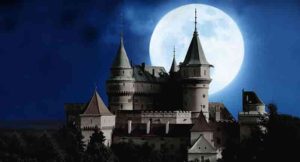For Dungeons and Dragons 5e, Monk Way of Shadow characters should consider:
- A race with a Dexterity modifier and/or special feature
- Learn basic monk features using a short sword
- Use Way of Shadows abilities to enhance subterfuge
- Implement higher-level monk abilities with the character’s role
In DnD 5e, monks that take the Way of Shadow use their martial arts and ki abilities as master assassins and spies—essentially taking the form of a ninja. A campaign of stealth, martial combat, espionage and intrigue could be perfect for this character build. As fellow players pick the typical rogue subclasses, this character will add a different flavor of combat to encounters with guards and cutthroats.
If you’d like a premade adventure to try this shadow monk in, consider my original pirate adventure, Dead Man’s Tale. Click here or below to learn more.
A race with a Dexterity modifier and/or special feature
Races such as wood elf, tabaxi, halfling, kenku or goblin are awesome choices for this build.
Wood elves make fantastic monks of any kind, hitting both the Dexterity and Wisdom bonuses. With +2 to Dexterity and +1 to Wisdom, wood elves are built for fast-paced combat and subtle magic. Also, they have the added benefit of Mask of the Wild to blend into nature and an increased speed of 35 feet.
A dark, raven-like kenku could make for an interesting character. With a Dexterity modifier of +2 and a Wisdom modifier of +1, these birdlike creatures are natural monks. Plus, kenku have bonus skills in Stealth, forgery and mimicking the voices of others. We may have a winner here.
Learn basic monk features using a short sword.
Before we unlock our Way of Shadows abilities, we’ll need to build a monk that uses a deadly weapon. Therefore, this character should use something like a short sword (1d6) as a primary monk weapon.
Martial Arts will grant my monk the ability to use my Dexterity modifier for any monk weapon. Also, I’ll be able to throw a bonus unarmed attack using 1d4 + Dexterity modifier as my damage. Along with this bonus attack, I’ll receive Unarmored Defense and use my Wisdom + Dexterity modifiers +10 as my AC. Next, I’ll learn Unarmored Movement at level 2, which grants me 10 more feet of movement speed.
Kicking it into mystical kung fu mode, I’ll receive my Ki abilities, which unlock a special set of moves I can perform. These moves are:
- Flurry of Blows allows me to throw another unarmed bonus attack.
- Step of the Wind allows me to Dash or Disengage as a bonus action.
- Patient Defense allows me to use Dodge as a bonus action on my turn.
Deflect Missiles is another unique monk ability I could use to high degree. When a projectile is shot at me, I can reduce the damage by 1d10 +Dex modifier + Monk level. If I reduce this damage to zero, I can catch the arrow or projectile and throw it back. This bonus attack would count as a monk weapon, dealing 1d4 + Dex modifier. However, that takes a ki point, so I might want to just drop it.
Related Posts:
Guide to Building a Monk Way of the Drunken Master: DnD 5e
| Guide to Building Ninja Characters: DnD 5e
|
Use Way of Shadows abilities to enhance subterfuge
When I choose the Way of Shadows at level 3, my ki points can be spent on shadowy spells. Shadow Arts allows me to spend 2 ki points to cast darkness, darkvision, pass without trace or silence. Plus, I can cast minor illusion as a cantrip.
Darkness creates an area effect of complete blackness, blinding groups of enemies. Darkvision allows the caster to see better in the dim and dark light. Pass without trace causes a group effect where an entire party can hide from enemies. Silence is another spell that wipes out the noise I make, which comes in handy against monsters with heightened hearing.
The ninja skills increase as I level up. At level 6, Shadow Step allows me to teleport up to 60 feet wherever shadows fall. Cloak of Shadows comes at level 11, which gives me the ability to turn invisible as an action in dim light or darkness. Finally, I learn Opportunist at level 17, which gives me a bonus attack whenever an ally hits a creature within 5 feet.
Implement higher-level monk abilities with the character’s role
Playing this type of monk relies on cunning and support, ambushing foes with heightened maneuverability and stealth. As I move through the combat field, I will hammer foes with Stunning Strike (level 5), a paralyzing attack that stuns opponents until the end of my next turn on failed Constitution saves. This strategy can have huge effects on enemy damage output of the encounter.
By level 7, I will master combat against ethereal and magic threats with Ki-Empowered Strikes and Evasion. Ki-Empowered Strikes allow my unarmed strikes count as magical, hitting foes who resist nonmagical attacks. Evasion allows me to fully dodge an area of effect blast like fireball, fully negating the damage.
Higher level monk abilities tend to focus on the resistance of status effects, such as Stillness of Mind (charmed or frightened) and Purity of Body (disease or poison). However, Tongue of the Sun and Moon (level 13) grants me understanding of all languages. I can play this aspect up during role play, communicating with strange beings or exotic people.
This monk is capable of consistent damage output, even if it isn’t as high as other classes. I like to think of monks as tactical specialists and sources of wisdom. The ninja flavor of the Way of Shadows allows me to play this wisdom in a darker manner. Using this, I can generate an interesting character who acts as overall support for the party. Plus, I get to ambush opponents and barrage them with martial arts.
Related Posts:
Guide to Building a Mystery Campaign: DnD 5e
| Guide to Building Shadow Magic Sorcerers: DnD 5e
|






